Introducing solid foods to your baby is a major nutritional milestone, and choosing the right approach can shape a child’s long-term eating habits and health. Among the most effective and developmentally supportive methods is baby-led weaning (BLW), a practice that encourages infants to self-feed with age-appropriate solid foods from the start of weaning. As more parents move away from purees and toward whole food textures, interest in led weaning recipes has surged. These recipes not only support independent feeding but also foster a love for diverse flavors and healthy choices. In this guide, we explore the foundational principles behind BLW and offer a comprehensive suite of nourishing, easy-to-prepare recipes to help babies meet vital developmental and nutritional benchmarks.
You may also like: Essential Milestones in Baby Led Weaning: A Proven Guide to Nurturing Healthy Eating Habits
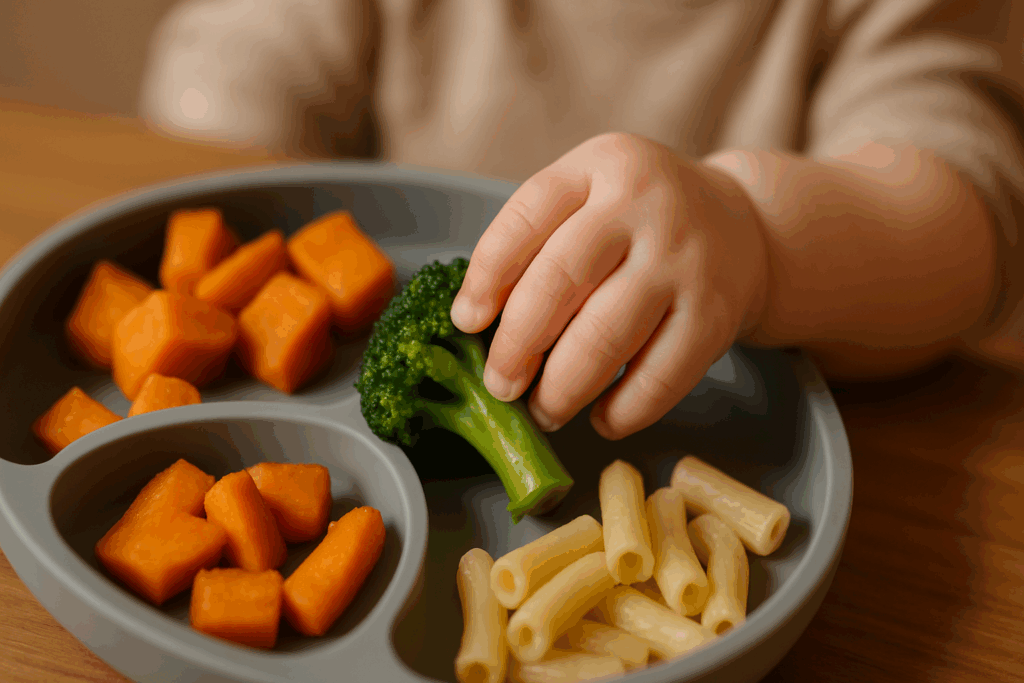
Understanding the Fundamentals of Baby-Led Weaning
Baby-led weaning emphasizes autonomy and sensory engagement in early feeding. Rather than spoon-feeding mashed or pureed foods, caregivers offer appropriately sized and textured foods that babies can grasp and explore on their own. This hands-on method respects a child’s ability to regulate hunger and satiety, promotes oral-motor development, and cultivates fine motor skills essential for self-feeding. By allowing infants to be active participants in their eating journey, BLW also builds their confidence and curiosity around food.
Research has shown that babies who follow baby-led weaning may be less likely to become picky eaters, partly because they are exposed to a wide range of textures and flavors early on. Furthermore, these infants often learn to recognize hunger and fullness cues more effectively than those fed via traditional methods. Nutritionally, BLW allows babies to eat what the rest of the family eats—with minor adjustments for safety—which can lead to more balanced diets rich in whole foods.
It’s essential, however, to be informed and cautious when practicing BLW. While it provides numerous benefits, caregivers must be vigilant about choking hazards, nutrient density, and food allergies. Offering soft-cooked, age-appropriate foods and closely supervising meals ensures that this approach remains both safe and effective.
Why Led Weaning Recipes Are a Vital Resource for Parents
One of the most common questions parents ask is how to craft meals that are both safe and nourishing for a baby beginning their led weaning journey. Led weaning recipes serve as blueprints for offering variety, nutrition, and enjoyment in the early stages of food exploration. These recipes help eliminate guesswork, making it easier for families to plan meals that align with both nutritional milestones and developmental readiness.
From a practical standpoint, led weaning recipes are also time-savers. Many are designed to be prepared in batches, stored easily, and enjoyed by the whole family—streamlining mealtime preparation. They also emphasize nutrient-rich ingredients like iron-fortified grains, healthy fats, soft proteins, and fiber-rich vegetables, which are critical for supporting an infant’s rapid growth and brain development.
Moreover, these recipes often take into account allergenic foods and how to safely introduce them. With pediatric guidelines now encouraging the early introduction of potential allergens like peanuts and eggs (under medical guidance), structured recipes can provide a systematic, evidence-based way to do so. Overall, led weaning recipes act as foundational tools for establishing healthy eating patterns that persist well into childhood.

The Nutritional Science Behind Baby-Led Weaning Meals
Nutrition during the first year of life is especially critical, as it lays the foundation for lifelong health. As breast milk or formula remains the primary source of nutrition for the first 6-12 months, solid foods introduced during baby-led weaning should be considered complementary but still impactful. High-quality baby led weaning meals must focus on meeting the unique nutritional needs of infants, which include adequate intake of iron, zinc, healthy fats, and vitamins A, D, and B12.
One of the challenges with BLW is ensuring adequate iron intake, as breast milk contains relatively low levels of this essential mineral. Led weaning recipes often incorporate iron-rich foods like lentils, chickpeas, ground meats, tofu, and fortified cereals to compensate. These ingredients are prepared in textures that are easy for babies to gum or chew, such as soft patties or steamed finger foods.
Additionally, good baby led weaning ideas include sources of healthy fats, which are vital for neurological development. Foods like avocado, nut butters (spread thinly and monitored carefully), chia seeds, and full-fat dairy contribute to both brain health and calorie needs. Fiber from vegetables and whole grains supports digestion, while the inclusion of varied colors and flavors aids in palate development and food acceptance.
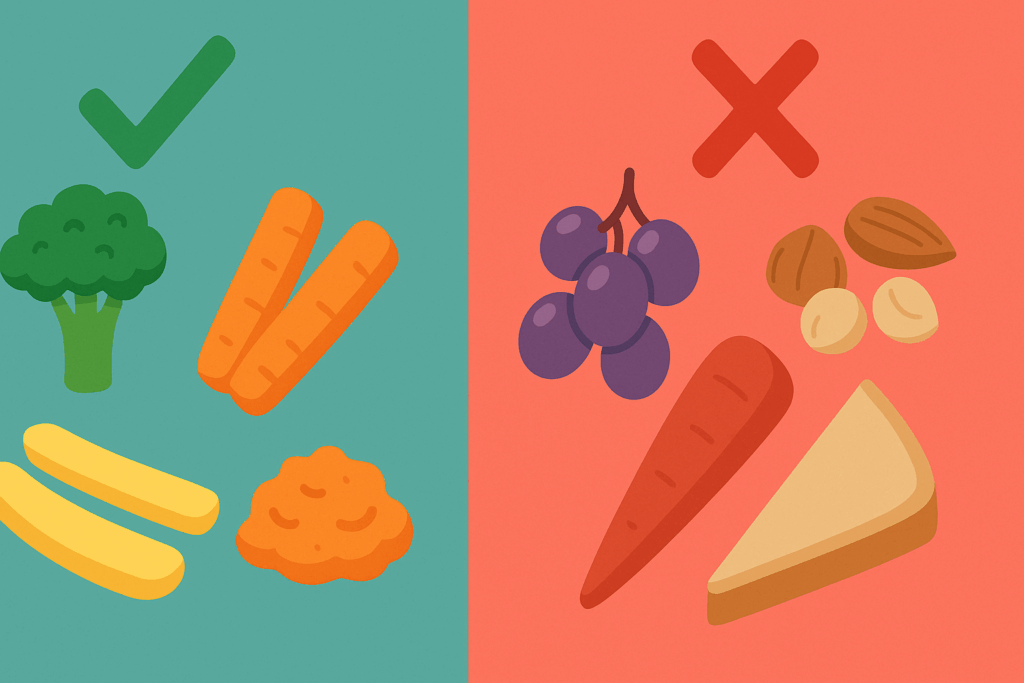
Navigating Common Concerns and Safety in Baby-Led Weaning
As empowering as BLW is, it also comes with its fair share of concerns for new parents. The most pressing of these is the risk of choking. While baby-led weaning does not increase choking risk when practiced correctly, understanding how to prepare food safely is paramount. All foods should be offered in soft, finger-length pieces or mashed textures that babies can handle without hazard. Ingredients like whole grapes, raw apples, hard nuts, and stringy meats should be avoided or modified appropriately.
Equally important is allergen management. According to current pediatric guidelines, introducing allergens between 6 and 12 months can actually reduce the likelihood of allergies later in life. Led weaning recipes can help caregivers incorporate ingredients like scrambled eggs, yogurt, and nut butters in a measured and safe way. It is always advisable to introduce new allergens one at a time and during the daytime when medical attention is more readily available if needed.
Other concerns include ensuring meal balance and portion control. Although BLW allows babies to self-regulate intake, offering meals with a variety of nutrients ensures comprehensive development. Smart blw ideas include combining a protein, a vegetable, and a carbohydrate in each meal, which mimics the structure of balanced family plates and supports holistic growth.
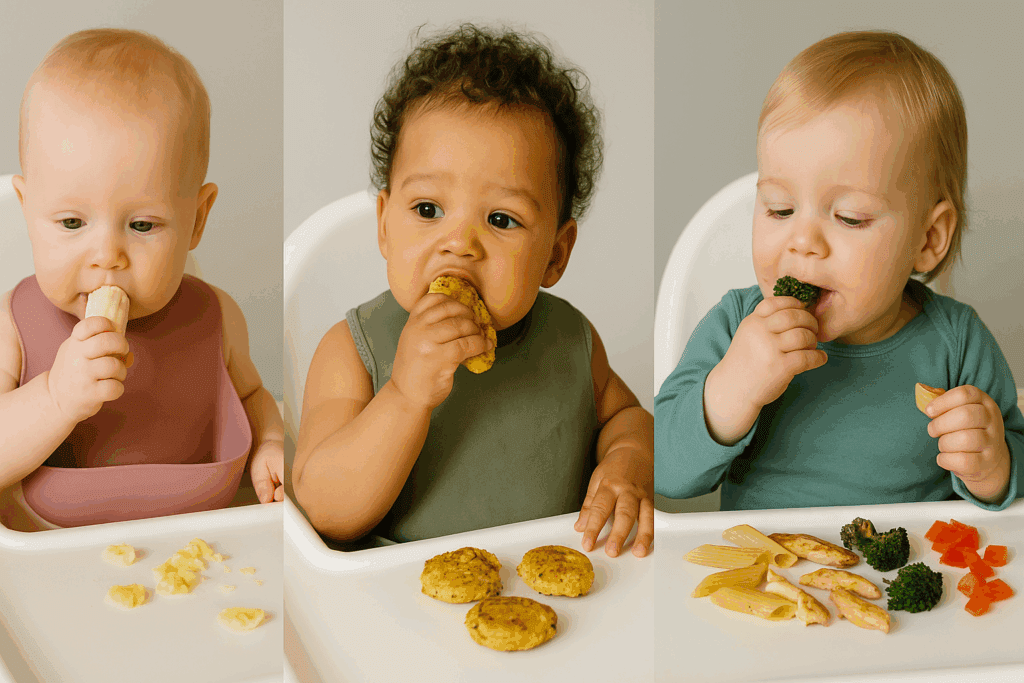
Led Weaning Recipes That Support Key Milestones in the First Year
The first year of life is a time of extraordinary growth. By six months, most babies are ready to explore solid foods alongside breast milk or formula. At this stage, simple led weaning recipes like steamed carrot sticks, avocado slices, and soft banana segments serve as gentle introductions to texture and taste. These foundational foods are nutrient-dense, easy to digest, and safe for self-feeding.
As babies approach the eight-month mark, their fine motor skills and chewing ability typically improve, allowing for more varied and complex meals. Baby led weaning meals at this stage might include soft-cooked pasta shapes, mini vegetable fritters, or scrambled eggs with spinach. Recipes can incorporate iron-rich legumes and fortified grains, ensuring that nutritional needs are met without compromising safety.
By twelve months, many infants are capable of eating most family meals, with small modifications. At this point, led weaning recipes can mirror adult dishes with simplified seasoning and careful preparation. For example, a quinoa and sweet potato patty or a mild curry with soft vegetables becomes both a delicious and developmentally appropriate choice.
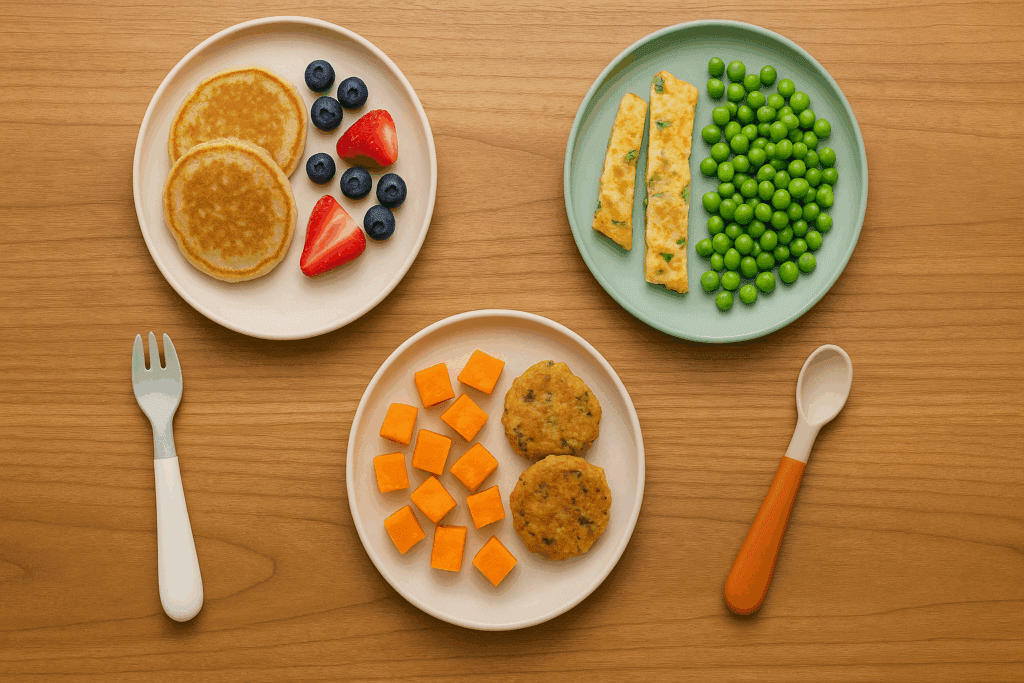
Blw Food Ideas for Breakfast, Lunch, and Dinner
Creating a full-day meal plan using baby-led weaning principles helps establish a routine and supports consistent exposure to new foods. For breakfast, blw food ideas include mashed avocado on toast strips, banana oat pancakes, or Greek yogurt with mashed berries. These options provide calcium, healthy fats, and fiber to fuel a busy morning of play and development.
Lunch might feature blw lunch ideas like soft quesadillas filled with black beans and cheese, mini turkey meatballs with roasted carrots, or a soft vegetable omelet cut into strips. These meals offer iron, protein, and a mix of colors and textures to keep babies engaged and well-nourished.
Dinner can round out the day with blw meal ideas like salmon and sweet potato bites, lentil and rice patties, or steamed broccoli with a side of hummus for dipping. Serving these meals alongside the family encourages social bonding and positive mealtime behaviors. Additionally, offering water in a small open cup supports motor development and hydration habits.
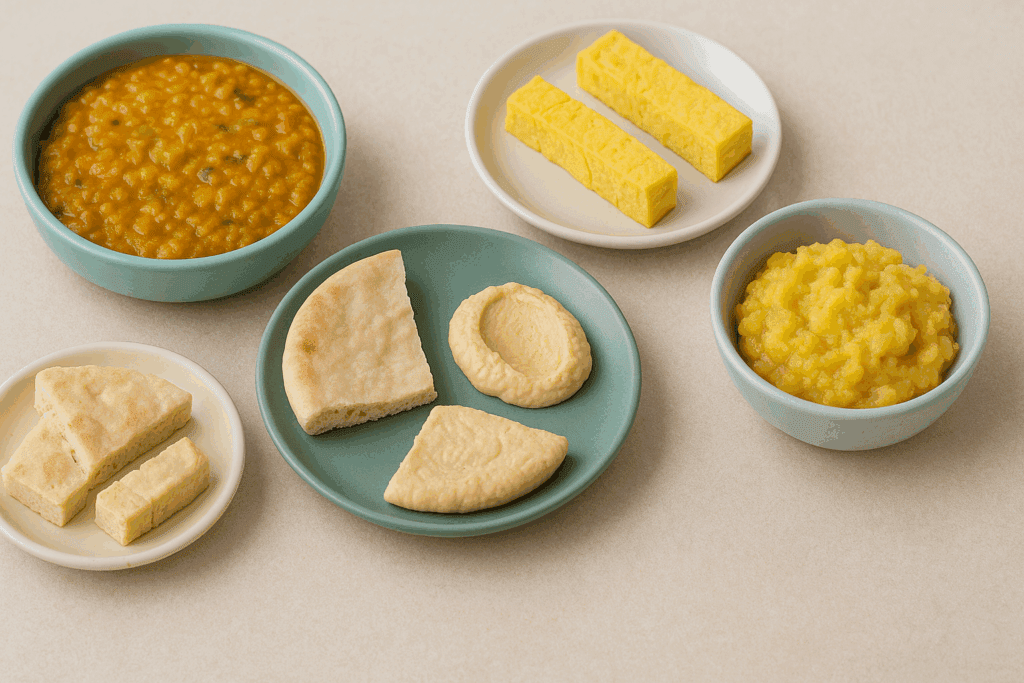
Culturally Diverse BLW Recipes for Expanding Baby’s Palate
Incorporating cultural diversity into baby’s diet from the start not only broadens their palate but also fosters inclusivity and appreciation for global cuisine. Led weaning recipes with international flair can expose infants to a wide array of flavors, textures, and nutrients. For instance, soft tamago-style scrambled eggs, mild Indian lentil dal, or mashed plantains are excellent baby led weaning ideas that reflect different culinary traditions.
Middle Eastern blw recipes might feature labneh spread on soft pita, finely chopped tabbouleh with couscous, or tender lamb cooked with sweet potatoes. From East Asia, steamed rice cakes, silken tofu with sesame, or miso-glazed carrots make engaging and nutrient-dense options. When introducing international ingredients, it is vital to reduce salt and spice levels while preserving authentic flavor profiles.
Culturally inspired blw meals also provide a meaningful way for families to share heritage and traditions with their children. By adapting family recipes into baby-friendly formats, caregivers promote connection, continuity, and a positive relationship with food that begins early and endures for life.
Led Weaning Recipes with Iron-Rich Ingredients for Optimal Growth
Iron deficiency is a common concern during infancy, especially in breastfed babies, making iron-rich led weaning recipes essential. These recipes can feature animal-based sources like ground beef, turkey, and chicken liver—all cooked until soft and presented in baby-friendly forms such as meatballs or strips. Blw meals using legumes, like lentil mash or chickpea fritters, offer plant-based alternatives suitable for vegetarian families.
Combining iron-rich foods with vitamin C sources enhances absorption. For example, serving spinach pancakes with a side of mashed strawberries or incorporating bell peppers into a quinoa patty boosts iron uptake. Fortified baby cereals used as coating for soft chicken nuggets or added to muffins also help close the nutrient gap.
Regular inclusion of these foods in blw meal ideas ensures steady growth, supports brain development, and prevents anemia. Making iron intake a daily priority through smart and delicious recipes lays the groundwork for robust health in early childhood.
Blw Recipes That Grow with Your Child: Transitioning to Toddler Meals
As babies become toddlers, their nutritional needs and taste preferences evolve. However, the foundational habits developed through baby-led weaning make this transition smoother and more intuitive. Many led weaning recipes can be adapted into toddler-sized portions and expanded with new flavors and ingredients.
For example, a baby-friendly vegetable patty can be transformed into a toddler meal by adding herbs, dipping sauces, or whole grain sides. Soft fruit used in early blw ideas might be served atop whole grain waffles or alongside cheese cubes to increase complexity. As chewing skills improve, textures can gradually shift from soft to firmer, supporting oral development and expanding food repertoire.
Toddlers often assert independence and show food preferences more strongly. Continuing to offer a range of foods without pressure encourages adventurous eating and builds resilience against picky habits. Shared family meals, consistent routines, and joyful exploration remain as critical in toddlerhood as in the infant stage.
Overcoming Mealtime Challenges with Creative BLW Strategies
Despite best efforts, some babies may resist certain foods or become disinterested during meals. In these moments, creativity and patience are key. One effective strategy is food play: allowing babies to explore textures and shapes through touch, even if they don’t immediately consume the food. This sensory engagement often leads to greater acceptance over time.
Rotating blw food ideas regularly prevents mealtime boredom and encourages curiosity. For example, presenting a familiar food like sweet potato in new forms—mashed, roasted, or in patties—can rekindle interest. Similarly, incorporating dips like yogurt or tahini can make vegetables more enticing and provide extra nutrients.
Another strategy is involving older siblings or parents in the feeding process. When babies observe others eating the same food, they are more likely to try it themselves. Above all, maintaining a low-pressure environment and responding to hunger cues promotes a lifelong positive relationship with food.
Frequently Asked Questions: Practical Insights for Mastering Led Weaning Recipes and Meal Strategies
How can parents balance led weaning recipes with daycare meal routines?
Integrating led weaning recipes into a child’s daycare schedule requires collaboration with caregivers and a thoughtful approach to food prep. Start by providing a list of safe, age-appropriate baby led weaning meals that align with what your child eats at home. These should include familiar textures and ingredients to reduce confusion or reluctance in a new environment. For practical implementation, prepare blw meals in labeled containers with clear instructions on portion size and serving method. Including a mix of cold-serve options like soft fruit slices and prepared patties allows for flexibility during meal times. Open communication with daycare staff about your feeding preferences and safety considerations ensures consistency and supports your child’s independence, even outside the home.
What are the best strategies for introducing seasonings in baby led weaning meals?
Contrary to common misconception, babies can enjoy a range of seasonings once they begin solids—salt and sugar excluded. Gradually incorporating mild herbs and spices into baby led weaning recipes enhances flavor exposure without overwhelming the palate. For instance, cinnamon pairs well with sweet potatoes, while a hint of turmeric can elevate lentil-based blw recipes. Parents should introduce one new seasoning at a time, observing any sensitivity, and avoid spice blends that contain salt or artificial additives. These subtle additions support early flavor training and lay the groundwork for long-term acceptance of diverse blw food ideas.
How do blw meals evolve for children with developmental delays or oral-motor challenges?
Children with developmental delays may require adaptations to traditional baby led weaning ideas, but they can still benefit from the core principles. Focus on textures that are extra soft yet shaped to encourage grasping and chewing. You might modify classic blw recipes into purée hybrids by preparing soft patties or veggie mashes with a spoonable texture while still promoting self-feeding. Occupational therapists often recommend silicone feeders or soft utensils to build oral strength and dexterity during meals. With patience and tailored support, these children can safely participate in led weaning recipes while progressing at their own pace.
How do led weaning recipes support long-term food literacy and emotional health?
Led weaning recipes do more than nourish the body—they create a foundation for lifelong food confidence and emotional well-being. When children are encouraged to explore textures, flavors, and eating tools on their own, they develop autonomy and trust in their own instincts. Over time, this approach reduces anxiety around food choices and supports the development of intuitive eating habits. By framing meals as interactive and stress-free experiences, baby led weaning meals can prevent the emergence of food-related power struggles or emotional dependencies. Furthermore, shared mealtimes rooted in these principles often promote stronger family bonds and communication.
What role do sensory textures play in successful baby led weaning recipes?
Texture is a critical but often underappreciated element in baby led weaning recipes. Babies use their hands, mouths, and even their noses to understand food through touch, smell, and taste. By offering a variety of blw food ideas that span from smooth avocado slices to lightly crisped vegetable fritters, caregivers stimulate multiple sensory pathways that support brain development and oral-motor coordination. Textural diversity also helps reduce future picky eating by normalizing the feel of different foods from an early age. As your baby matures, you can gradually increase the complexity of textures to match evolving chewing skills and sensory tolerance.
How do cultural influences shape blw lunch ideas across different regions?
Cultural context plays a profound role in shaping baby led weaning meals around the world. In many Asian households, blw lunch ideas may feature steamed rice rolls or tofu bites, while Mediterranean families might serve soft falafel and cucumber strips with hummus. These culturally rich led weaning recipes introduce children to the sensory traditions of their heritage and reinforce identity through shared mealtime rituals. Adapting regional dishes into blw recipes ensures that babies participate in cultural continuity while still receiving balanced, age-appropriate nutrition. Caregivers should prioritize whole food ingredients and reduce salt or spice intensity to make traditional foods suitable for little ones.
How can led weaning recipes address the specific needs of vegetarian families?
Vegetarian households can thrive on led weaning recipes by prioritizing plant-based proteins and iron-fortified foods. Lentils, chickpeas, soft-cooked quinoa, tofu, and nut butters (used safely) offer robust nutritional value in blw meals. Pairing these with vitamin C-rich foods like sweet potatoes or bell peppers enhances iron absorption, compensating for the absence of animal products. For texture and variety, blw recipes such as lentil-spinach bites or mashed white beans with soft toast are satisfying and developmentally appropriate. It’s also important to regularly include high-fat foods such as avocado or full-fat dairy to meet energy needs and support brain development in vegetarian-fed infants.
What are the most overlooked blw ideas for snack time and in-between meals?
Snack time is often viewed as an afterthought, yet it offers key opportunities for nutritional enrichment and sensory exploration. Overlooked blw ideas for snacks include steamed pear slices sprinkled with cinnamon, chia-seed banana bites, or mashed peas on oat crackers. These options provide essential micronutrients and can be prepared in bulk to reduce daily prep time. Incorporating snacks into the rhythm of the day also reinforces consistent hunger cues and reduces reliance on milk feeds as the child transitions to solids. Including snack-appropriate led weaning recipes helps maintain balance and energy levels without disrupting the appetite for main meals.
Can baby led weaning recipes be adapted for travel or outdoor settings?
Traveling or dining outdoors with a baby doesn’t mean abandoning blw principles. With a little planning, caregivers can prepare portable led weaning recipes such as soft veggie muffins, egg-free pancakes, or sliced fruit stored in breathable containers. Focus on blw meal ideas that are less messy and can be served cold or at room temperature. Pre-cut blw food ideas like cheese cubes, roasted chickpeas, and avocado-stuffed wraps are ideal for outings. Packing a spill-proof cup, bib, and sanitizing wipes ensures a smoother experience while preserving the values of self-feeding and family meal integration, no matter the setting.
What are some expert-level blw recipes that incorporate emerging nutritional trends?
Modern nutrition continues to evolve, and blw recipes can reflect these innovations while remaining safe for infants. For example, spirulina can be added in trace amounts to vegetable pancakes for an antioxidant boost, or flaxseed blended into mashed banana can increase fiber and omega-3 intake. Baby led weaning ideas now increasingly include ancient grains like millet or teff, which offer superior mineral content and textural diversity. Fermented foods like unsweetened kefir or mild sauerkraut can be introduced in moderation to support gut health. These elevated blw meals demonstrate how baby led weaning can remain dynamic, evidence-based, and nutritionally progressive for today’s health-conscious families.
Conclusion: The Lasting Benefits of Led Weaning Recipes for Lifelong Healthy Eating
As we reflect on the profound role that led weaning recipes play in shaping early nutrition, it becomes clear that they are far more than just meal ideas. They are instruments for building developmental skills, forming lasting food preferences, and supporting critical physiological milestones in infancy and toddlerhood. When thoughtfully crafted and consistently implemented, these recipes offer an empowering path to self-regulation, independence, and joy in eating.
By embracing baby led weaning ideas that prioritize nutrient density, sensory diversity, and family inclusion, caregivers can lay a strong foundation for healthy growth and cognitive development. Whether through iron-rich lentil patties, blw lunch ideas like vegetable-stuffed quesadillas, or blw recipes adapted from global cuisines, each dish becomes an opportunity to nurture both body and spirit.
Ultimately, the journey of baby-led weaning is not just about what babies eat—it’s about how they learn to engage with food, family, and the broader world. These first experiences at the table are stepping stones toward a lifetime of mindful nourishment, making the investment in led weaning recipes one of the most rewarding decisions a parent can make.
Further Reading:
63 Safe Baby-Led Weaning Foods: The Ultimate Guide + Free Printable
Starting Solids: Annabel Karmel’s Handy First Foods Checklist



